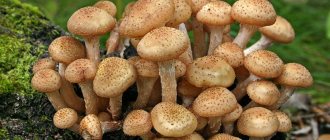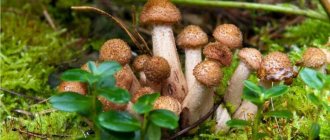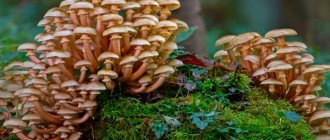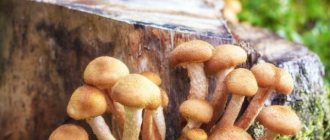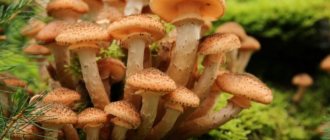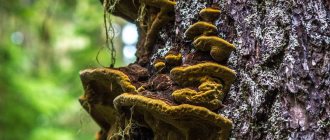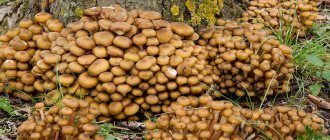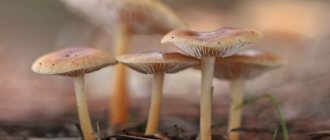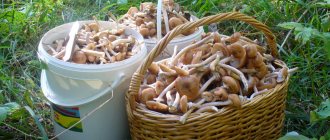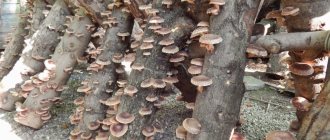Autumn is the rainy season, which means mushroom season! Each of us who visited the countryside during this wet season could see a huge number of mushroom pickers with large baskets full of this delicious gift of nature. And many people like to spend their day off in unity with nature, walking in the forest and stocking up on porcini mushrooms, honey mushrooms, russula, and saffron milk caps.
But when should you go after them? While experienced mushroom pickers know how long it takes a particular mushroom to grow, beginners often rush into the forest immediately after the rain, but collect nothing but dirt on their shoes. Therefore, today we’ll talk about when to go for the gifts of nature after the rains.
Features of growing honey mushrooms
In nature, honey mushrooms grow in large groups on fallen trees and stumps.
- These are hemp mushrooms that actively reproduce on moistened wood of deciduous trees. They do not germinate on rotten plants. This growing method is also practiced at home. Mycelium grows with proper care in a greenhouse, as well as in glass jars.
- If there are freshly cut trees in the garden plot, it is better to choose the main method of cultivation and not risk future honey mushrooms. If not, sprouting mycelium in a jar will do. The body of the fruit or a piece of wood where they sprouted earlier is used as planting material.
- The time for growing mycelium on stumps (or with other methods of maintenance) depends on weather conditions. Usually they go to the forest to pick mushrooms after the rain, expecting to get a rich harvest. In artificially organized conditions, climate also plays an important role.
The more precise and better the growing conditions are, the faster the growth rate will be. The average readiness of mycelium for harvesting is 7-8 days.
Collection and transportation
In the forests you can find many fragrant honey mushrooms, the appearance of which many look forward to with great impatience. Collecting them is a real pleasure. The fact is that they can be found in forests in whole families, so the mushroom picker immediately picks up a full basket, and sometimes you even have to go several times.
Everyone knows the sulfur-yellow, false honey fungus. It's not worth collecting. Sometimes you can find such a representative with a cap with a diameter of 6 cm, which has a bright yellow color with small “inserts” of red. False mushrooms have no scales on their caps.
The legs are yellow and brown at the base. Their length can reach 7 cm, and their diameter is 1 cm. They have no rings. Mushrooms taste bitter when consumed.
Honey mushrooms are very easy to transport from the forests where they grow. The harvested crop is placed in bags and buckets, car trunks and large baskets. Delivering them to the recycling site is quite easy. Mushrooms found on stumps must be transported within a short period of time, otherwise they will spoil.
Dependence of mycelial growth on air temperature
They often rely on air temperature. Reproduction of mycelium on stump begins already at a temperature of 3°C-4°C (spores of winter, autumn and spring honey mushrooms germinate). The mushroom grows under such conditions for up to 30 days. The rate of germination changes with fluctuations in night and day temperatures.
A favorable indicator for active mycelium growth is 16°C-26°C. Without temperature changes and high humidity, summer and autumn varieties of fruiting bodies are able to grow and complete the period of active growth in just 8-9 days. If the indicator is higher, the germination rate slows down.
When the thermometer exceeds 30°C, the honey fungus quickly deteriorates, especially if there is drought during its development.
Freezing mushrooms for the winter
The harvested honey mushrooms can be frozen fresh
or
after preliminary heat treatment
.
Freezing fresh mushrooms will preserve the taste and aroma of freshly cut mushrooms; after defrosting, they are suitable for preparing various dishes. Before freezing, honey mushrooms cannot be washed; you must manually remove all plant debris and dirt from the mushrooms.
Also pre-sort honey mushrooms by size, discard those with damage and rot. You can freeze in ziplock bags or plastic containers. Arrange the mushrooms in one layer; if there is a large quantity, they will simply stick together and lose their shape when defrosted. After freezing, they can be stored for 6 months at -18 degrees.
Freezing honey mushrooms with preliminary heat treatment
Before freezing, honey mushrooms are prepared using one of three methods: blanched, boiled or fried. After processing, honey mushrooms are stored for 3-4 months.
Growth of honey mushrooms in the forest
Temperature is important for mushroom growth
Meadow honey mushrooms (they are also called wild honey mushrooms) sprout on stumps; for active growth, they need a temperature of 20°C-23°C (summer) and 10°C-12°C (autumn and spring). High humidity of wood and air is also important for rapid ripening of fruiting bodies. Both autumn and spring and summer mushrooms require a combination of heat and moisture for rapid development.
Favorable humidity indicator is 50-65%. In just one day, an increase of 2-2.5 cm is observed. In the following days, only the cap develops. You can go for mushrooms 3-4 days after the rain.
If the parameters of heat and moisture are maintained at home, the edible fruit will germinate on the stump up to 4 times a month.
Description of mushrooms
Before going to the forest, you need to know what honey mushrooms look like so as not to confuse them with a poisonous variety.
The most typical mushrooms for the Moscow region have a thin stem, up to 10-12 cm in height, a convex cap of a slightly yellowish or brown color with a light spot in the center. As they grow older, the cap flattens, the spot becomes smaller, and sometimes disappears completely. Edible honey mushrooms in the Moscow region are represented by several types:
- Spring and summer species prefer rotting deciduous trunks or rotten stumps. The colonies are the most numerous. The cap is small, up to 5 cm in diameter, the flesh is slightly watery, the smell is of freshly cut trees, with which the mushrooms form a symbiosis. Other names: talker, linden mushroom.
- Meadow grass, meadow grass or non-rotting grass is small, with a smooth cap of creamy or creamy color and uneven edges, up to 3 cm in diameter. The flesh is pale yellow, the aroma is almond, the taste is bitter. It is most often mistaken for a poisonous mushroom. It is found in open areas, pastures, forest edges, the sides of dirt roads, and at the edges of ravines. Forms rows or circles.
- Autumn honey mushrooms are the most numerous. They fit the description of classic mushrooms of this species. One by one they almost never come across. They look “noble” - a honey-brown or reddish cap, darker in the center, begins to flatten only on the 7-9th day of life, the cap reaches 10 cm in diameter. The pulp is light, milky or creamy white, dense, the smell is pleasant, like fresh sawdust. Can be found in forests, in forest parks.
- The correct name for the winter honey fungus is Flammulina velvetypodia. Forms numerous colonies, prefers old trees, rotting trunks on the edges or near streams. The caps are yellowish, pale orange, brownish - the edges are light. The pulp is creamy, with a refined delicate aroma.
Honey mushrooms grow in foxes, in parks, and you can find a colony in your own garden plot. In this case, you should cut it very carefully to preserve the mycelium. Then the colony will be restored every year and there will be no need to waste time on long trips.
Germination rate of autumn mushrooms
Autumn mushrooms, collected in September and early October, are the most popular among mushroom pickers. It's the start of the rainy season, but the weather is still warm outside. This period is considered the most productive time for collecting mushrooms.
In autumn, honey mushrooms grow most quickly. From the end of August to mid-October, the mycelium grows in just 8 days. In the event of heavy rain, it takes even less time to grow. The fruiting body is suitable for cutting already on the 4-5th day.
Autumn honey mushrooms have different growth rates, depending on the condition of the wood. On old and rotten wood, the mycelium grows faster because it absorbs moisture more easily. In just a day, their number often doubles, and a new, emerging mushroom, after 24 hours will have a leg 4-5 cm long and a cap with a diameter of 2-2.5 cm. The maximum growth of this mushroom reaches 14 cm at the cap size is 8-9 cm. If the mushroom exceeds this size, most likely it is false.
Description of honey mushrooms
Young fruiting bodies have convex caps with small scales. As the cap grows, it becomes flat and wide, and the scales most often disappear. The color of the cap varies from light honey to dark olive. Size 3–17 cm. The leg grows 7–12 cm in height and usually 1–2 cm in girth. Thin and light at the top, widens downward and acquires a dark color. Covered with a coating in the form of flakes.
Young fruiting bodies have a “skirt” on the stem, which disappears over time . Young fruiting bodies have denser pulp. In mature mushrooms, the stem acquires a tough, fibrous texture. The plates, hidden under very young caps, straighten and darken with growth.
Did you know? The first mushrooms appeared more than four hundred million years ago, long before the appearance of dinosaurs.
Rain and other factors affecting mushroom growth
The fact that mushrooms grow rapidly after rain is not a completely true statement. Rain alone cannot cause massive mushroom growth. A lot of other factors also influence the growth rate. The most significant of them are the following:
- Temperature.
- Humidity.
- Lighting.
- Chemical composition of the soil.
- Harmful insects.
The humidity factor involves two components: air humidity and soil moisture. Each species has its own preferences in this regard, but, if we take the statistical average, the optimal humidity level for good growth is considered to be 70%. Soil moisture should correspond to air humidity. If a prolonged drought occurs after heavy rains, the mushrooms will grow slowly because the moisture in the soil will evaporate quickly. Thus, the soil will become dry and the air will become waterlogged, which will upset the balance.
Mushroom growth
Proper lighting plays an important role in active mushroom growth. Many species prefer to grow in sunny meadows or partial shade. If the forest grows too much, they don't have enough light. As a result, they slow down their growth and become deformed, losing their visual appeal.
Most edible mushrooms prefer slightly acidic soil. The only exceptions are a few species that grow well in sandy, limestone or other types of soil. Interventions in the chemical composition of the soil lead not only to growth stagnation, but also to the extinction of entire fungal families.
Indicators of optimal temperature and humidity for mushroom growth
Mycelium with its terrestrial parts are at risk of infection by the larvae of some types of harmful insects. Affected myceliums bear fruit poorly, and the mushrooms are small and grow very slowly. Mechanical damage provokes rot and other serious diseases. Active growth of most mushroom species occurs in the fall. Then the process of mass decay begins.
In the understanding of most, mushrooms are fruiting bodies, most often consisting of a stem and a cap. In fact, it is only the terrestrial part of a complex organism. The mycelium, or mushroom place, is located under a layer of soil, growing systematically throughout its life. The growth of mycelium is not affected by weather conditions; it grows equally both after heavy rain and during severe frosts.
In what places to look for honey mushrooms?
These mushrooms appear in damp places after the onset of heavy autumn rains. They are usually located on tree trunks, stumps, and in rare cases, on the cuttings of fallen leaves.
They also grow on large broken branches. Honey mushrooms rarely grow alone, so most often they are found in large growths on various stumps.
Depending on the species, mushrooms grow in different places. Spring honey mushrooms mainly grow in meadows, pastures and forest edges. That’s why they are called “Meadow”.
The Physalacriaceae family is found in forests with high levels of humidity. They also grow on stumps and tree trunks. But this species begins to grow only several years after deforestation. Mushrooms are often found growing near large ravines, as well as along their edges.
After 2-3 years, the first shoots appear on the stumps of birch, aspen and alder. The mycelium does not form quickly. And in pine and oak forests, growth begins 8-9 years after cutting down.
It is recommended to go to old, damp forest areas, in the soil of which many of the necessary substances for the growth of mycelium have already accumulated. Such favorable conditions contribute to the rapid and massive growth of honey mushrooms.
It is believed that the Northern Hemisphere produces more crops than the Southern Hemisphere. This is due to the climate and soil characteristics in different areas.
The best time to collect different types of mushrooms is in summer and autumn
The first mushrooms appear in April, but May is considered the official opening month of the mushroom season. Usually mushroom hunting lasts until October inclusive. But if weather conditions are favorable, new mushrooms grow in November and even in December.
It is better to harvest according to the mushroom calendar. Based on his data, the mushroom picker is less likely to run into an inedible double. The following table details the entire growth period of certain edible species.
| Species name | May | June | July | August | September | October |
| Porcini | + | + | + | + | + | |
| Valuy | + | + | + | + | + | |
| Volnushka | + | + | + | + | + | |
| Volnushka white (Belyanka) | + | + | ||||
| Gorkushka | + | + | + | + | ||
| Gruzd | + | + | + | + | ||
| Raincoat | + | + | + | + | + | |
| Greenfinch | + | + | + | |||
| Kozlyak | + | + | + | + | ||
| Cap | + | + | + | + | ||
| Chanterelle | + | + | + | + | + | |
| Oiler | + | + | + | + | + | |
| Mosswort | + | + | + | + | ||
| Honey fungus | + | + | + | |||
| boletus | + | + | + | + | + | + |
| Boletus | + | + | + | + | ||
| Ryzhik | + | + | + | + | ||
| Ryadovka | + | + | + | |||
| Serushka | + | + | + | + | ||
| Violin | + | + | + | |||
| Morel | + | |||||
| Russula | + | + | + | + | + | + |
| Champignon | + | + | + | + |
The first harvest is much smaller than the harvest collected during the period of active mushroom growth. The following provides data on the peak growth activity of certain edible species.
| Species name | May | June | July | August | September | October |
| Porcini | + | + | ||||
| Valuy | + | + | ||||
| Volnushka | + | |||||
| Volnushka white (Belyanka) | + | |||||
| Gorkushka | + | + | + | |||
| Gruzd | + | + | ||||
| Raincoat | + | + | ||||
| Greenfinch | + | + | ||||
| Kozlyak | + | + | + | |||
| Cap | + | + | ||||
| Chanterelle | + | + | ||||
| Oiler | + | + | ||||
| Mosswort | + | |||||
| Honey fungus | + | + | ||||
| boletus | + | + | ||||
| Boletus | + | + | + | |||
| Ryzhik | + | + | ||||
| Ryadovka | + | |||||
| Serushka | + | + | ||||
| Violin | + | + | ||||
| Morel | + | |||||
| Russula | + | + | + | + | ||
| Champignon | + | + | + | + |
An interesting fact is that during Indian summer you can find varieties from all seasons of the year. And after it, mushroom pickers can only collect the remains of the autumn harvest and winter honey mushrooms.
Yellow-red and thick-legged honey mushrooms
Like last year, 2022 is rich in the germination of autumn subspecies, and more precisely, in the yellow-red and thick-legged species growing in deciduous forests. You can meet them on a thick blanket of maple and oak leaves.
A distinctive feature of these mushrooms, in comparison with other edible varieties, is their length, which is more than 7-8 cm. Overgrowths can reach a length of 13 cm.
Important!
The smaller the mushroom, the less toxins it contains. Therefore, small honey mushrooms are always used for cooking, while adults are subjected to heat treatment with repeated boiling, and then put into marinade.
Duration of the mushroom period for different species
In warm, sunny weather, many new mushrooms appear in the forest after a good rain. In order to determine the mushroom age, it is enough to simply know the duration of the growth period of certain species.
The most common types of Russia have the following growth periods:
- porcini mushrooms reach large sizes already 2-3 days after warm rain;
Most species grow in 3 to 5 days. Full ripening usually occurs on the 10th day. It is noteworthy that fungal organisms grow equally actively both during the day and at night, without wasting time on rest. As autumn approaches, growth slows down. This is due to a decrease in air temperature.
How to prepare honey mushrooms for the winter?
Storing honey mushrooms in winter is only possible in processed form.
But jars of marinades and pickles should not sit in a warm pantry for more than 4-5 months. The shelf life of pickled mushrooms in the refrigerator or cold cellar is 6-12 months. Not all honey mushrooms are suitable for pickling and pickling. What can be made from high-quality, but slightly overgrown honey mushrooms? It turns out that there are many ways to process and store even such tough and not very pleasant-tasting mushrooms:
- Freezing allows you to preserve all the valuable substances and taste of honey mushrooms. After thawing, the mushrooms resemble fresh ones and can be used to prepare soups, caviar, stir-fries and other dishes where they are cooked. Before placing honey mushrooms in the freezer, they should not be washed, otherwise they will freeze into a monolith during storage. Frozen mushrooms are stored for 6-8 months.
- Freezing with pre-boiling allows you to reduce the cooking time for dishes with mushrooms. Boiled honey mushrooms are drained in a colander to remove liquid and cool, and then placed in containers or bags. They can be stored in the freezer for about 1 year without loss of taste and beneficial qualities.
- It is very convenient to store fried mushrooms. To make canned food, before processing, you need to wash and cut the caps of large honey mushrooms. You can fry them in ghee, lard or vegetable fat. The taste of the preparations will be different depending on the added spices. Fried mushrooms are placed in sterile jars and filled with the fat in which the processing took place. The jars are immediately closed or rolled up. High temperatures leave no chance for microorganisms to survive, so such canned food can be stored in the refrigerator or cellar for up to 12 months.
- Even large mushrooms with hard legs can be processed. Prepared delicious caviar from honey mushrooms for the winter can be stored in a cold place for 5-6 months. It is very convenient to add to prepared dishes, or serve as an independent snack with potatoes. A sandwich with caviar made from mushrooms ground in a meat grinder is a self-sufficient breakfast.
Even slightly overripe honey mushrooms can be stored for the winter in the form of delicious canned food or frozen. If they already have hard legs, then only the caps are used for the blanks. The fibrous parts can be boiled and passed through a meat grinder along with the mushrooms selected for caviar.
How to dry and preserve honey mushrooms?
A special way to store mushrooms is drying. During this process, almost all moisture is removed from the fruiting bodies. As a result, their shelf life increases, reaching 2-3 years. But dried honey mushrooms themselves need proper storage.
For drying, you need to select medium-sized mushrooms that have opened. Before drying using the traditional method, you should very carefully select healthy specimens that are not damaged by worms. Drying occurs outdoors at room temperature, so mold or worms can transfer to healthy mushrooms.
Drying can also be done in special dryers. In these devices, the baking tray with mushrooms is heated to 50°C or more. The process is much faster, and it takes only a few hours until it is completely ready.
Store dried mushrooms in linen bags in a completely dry place. At high humidity, honey mushrooms absorb water vapor and can become moldy. During long-term storage, they need to be checked for moisture from time to time: if the caps have lost their fragility and become plastic, then the entire batch should be dried in the oven at a temperature of +70°C.
Honey mushrooms can be preserved in different ways. With proper processing, even conditionally edible agaric mushrooms become palatable and can be eaten for several months.
Rules and gathering places after rain
Experienced mushroom pickers always follow the basic rules of mushroom picking:
- Do not add suspicious fruits to your basket.
- Collect only well-known species, otherwise there is a risk of confusing edible mushrooms with their poisonous counterparts.
- Cut off the mushroom units with a knife, and do not break them with your hands, so as not to damage the mycelium.
- Do not harvest near roadways or industrial centers.
- Observe the subtleties of the technology for collecting and preparing certain types.
Each species has its own habitat preferences. The following table summarizes the distribution locations of the most famous types of mushrooms.
| Species name | Places of distribution |
| White | Old deciduous and coniferous forests, mainly under oaks |
| Valuy | Deciduous plantings |
| Volnushka | Coniferous plantations, deciduous forests |
| Belyanka | Coniferous plantations, deciduous forests |
| Gorkushka | Sunny forest glades |
| Gruzd | Mixed forests |
| Raincoat | Floodplain forests, glades, park areas |
| Greenfinch | Mixed type of forest plantations |
| Kozlyak | Mixed plantings |
| Cap | Sunny forest glades |
| Chanterelle | Deciduous and coniferous forest plantations |
| Oiler | Coniferous forest plantations |
| Mosswort | Deciduous and coniferous forests |
| Honey fungus | Dead deciduous trees |
| boletus | Deciduous forests, mainly under birch trees |
| Boletus | Deciduous plantations, mainly under aspen trees |
| Ryzhik | Mixed type of forest plantations |
| Ryadovka | Forest edges, bushes, parks and squares |
| Serushka | Floodplain forests |
| Violin | Mixed plantings |
| Morel | Floodplain forests |
| Russula | Coniferous and deciduous forests |
| Champignon | Shrubs, roadside plantings |
You can harvest mushrooms from May until the first frost.
Any avid mushroom picker will never miss the ripening season of such common forest gifts as honey mushrooms. The culture is widely known both in our country and abroad, and during the harvesting period of fruiting bodies, a huge number of collectors go to the forest. The popularity of the delicacy is explained by its bright taste and wide range of “uses” - mushrooms are an excellent independent dish, and can also be added to salads, soups, sauces or other culinary masterpieces.
To ensure that a foray into the forest does not become in vain, it is important to know at what time, under what conditions, where and how much honey mushrooms grow. Let's consider this issue in more detail, determining how to choose the best time to harvest the forest crop we are considering.
How quickly do mushrooms grow after rain: how to harvest first?
With the arrival of the summer season, a real mushroom picker wants to get out of the house, go to the forest, collect a good harvest and cook dinner from it.
But in order to implement this idea, you need to know where to go and what time is best to pick mushrooms. They all grow best in warm, humid conditions, meaning the time after rain is ideal for harvesting.
Knowing the information about how quickly mushrooms grow after rain, you can choose the best moment to go to the forest.
At what temperature do mushrooms grow?
The underground part of each mushroom, the mycelium, grows throughout the year. Frost or extreme heat is not a hindrance to this. For the formation of the above-ground part - the body of the fungus - moderate climatic conditions and a lot of moisture are required.
By observing the “behavior” of this plant, people managed to find out which mushrooms grow most likely and which ones grow very slowly. That's what came out of it:
- Boletus grows several centimeters per day.
- Porcini mushroom - after warm rain it reaches its usual size in 2-3 days.
- Boletus - the mushroom needs 4-5 days to fully ripen.
- Honey fungus – growth time is from a day to a week.
- Chanterelle - you can wait three weeks for it to grow to the desired size.
All of these mushrooms will grow well if rain is accompanied by temperatures favorable for growth. The most comfortable temperature for their ripening is from 10 to 24 degrees. If this figure is less or more, you should not hope for a good mushroom harvest.
How many days do mushrooms grow after heavy rain?
A mushroom is a living organism. It absorbs both beneficial and harmful substances.
If it grows in an ecologically clean area and optimal conditions are created for it, then after precipitation this growth accelerates significantly.
In just a day, an ordinary mushroom can reach a significant size and can be picked. Knowing how many days mushrooms grow after rain, you can always arrive in the forest on time and enjoy what you love.
To ensure that picking mushrooms and their further consumption are completely safe, you should follow a few simple rules, namely:
- since mushrooms absorb absolutely all the substances with which they are surrounded, they should not be collected near roads or in overly polluted areas;
- The product will only be beneficial if you manage to collect the mushrooms before the end of their growth period - after which the decay process begins;
- Some inedible mushrooms are very similar to those that can be eaten, and therefore it is worth learning to distinguish them, and always being careful.
Mushroom pickers have three periods of the year when they can do what they love.
- The first begins at the end of May and lasts throughout the next month.
- The second will need to wait until the end of July, and the third in the fall, when the first leaves begin to fall.
- And the closer we get to autumn, the slower the mushrooms grow after rain, because it gets colder.
How long does it take for mushrooms to grow after rain?
On the second day after it starts to rain, you shouldn’t immediately take your basket and go into the forest. To begin with, it is worth analyzing the following parameters:
- how warm it was during the rain and after it;
- if someone goes for a specific type of mushroom, it is worth taking into account their intensity and growth characteristics;
You can go for porcini mushrooms, boletus and aspen mushrooms on the second day after the rain, but for honey mushrooms and chanterelles you will have to wait almost a whole week.
It is imperative to go for mushrooms with a knife so as not to damage their root system. If you completely pull them out of the ground in a few years, their appearance in the forest will completely disappear.
You also need to check all your finds for damage - external quality is always a guarantee that this product can be eaten.
To find out how quickly mushrooms grow after rain, just ask experienced mushroom pickers and people who know the forest. Almost everyone knows at what temperature good mushrooms grow. If it is clear that the weather conditions are favorable for a good harvest, then you should not hesitate to go out into nature to search for mushrooms.
Mushrooms are plants that, due to their characteristics, have been combined into a separate kingdom. During rain and fog, they grow at an excellent speed - a day or several days.
It’s especially good if the rain is light and warm, because then you can find entire glades with mushrooms in the forest.
Now you have learned how quickly mushrooms grow after rain, and you will be able to boast of a naturally generous harvest, before other mushroom pickers.
Source:
Where and how honey mushrooms grow
Even a novice mushroom picker knows that the ideal place for the development of mushroom mycelium is fallen deciduous trees, dead wood and old stumps. It is on the listed surfaces that spreading colonies of the crop are most often found. However, it often happens that, coming to the forest thicket, a collector comes across overgrown fruiting bodies, the so-called burdocks, the taste and tenderness of whose pulp leave much to be desired. The conclusion is simple - the time for quiet hunting was chosen incorrectly.
In order to determine the ideal time for harvesting, it is necessary to rely on climate, weather conditions and minimal knowledge about the crop’s habitat:
- As for the summer representatives of the family, the appearance of fruiting bodies, as well as their abundant growth, are observed at an air temperature of 14-25 degrees Celsius.
- Winter, spring and autumn colonies grow when the positive mark reaches 3-5 degrees.
The cap is covered with scales.
How to distinguish false honey mushrooms from edible ones
False honey mushrooms grow just like real ones, in colonies on stumps and old trees. At first glance, they can easily be confused with edible fruiting bodies.
Important! If you are not sure whether a mushroom is edible, never eat it. It’s better to ask an experienced mushroom picker again or just throw away what you find
.
However, there are quite a few signs that can help distinguish a false honey fungus from an edible one:
- An adult Armillaria has a rim on its stalk, which is a remnant of the protective film that covered the plates of young fungi.
- False honey mushrooms have a much brighter color (yellow, gray-olive or brick-red) than true ones.
- True Armillaria has cream or slightly brownish plates at the bottom of the cap, while false Armillaria has yellowish-gray plates.
- Edible fruiting bodies have a pleasant smell, while false ones smell unpleasant to humans.
Favorable weather conditions for growth
Lack of precipitation, drought and high temperatures (over 25 degrees Celsius) have a detrimental effect on the mushroom mycelium - the fruits may not begin to grow at all, or they quickly die, losing moisture and collapsing from the inside.
Another unfavorable factor is sudden temperature changes (cold at night, scorching hot during the day). If fluctuations exceed the range of 10 degrees per day, the growth of honey mushrooms practically stops.
Excessive precipitation with frosts also does not contribute to a good harvest. If there is a heavy downpour once or twice in a few days, it’s time to run and check the “prey”. Has it been raining for weeks? Honey mushrooms will grow, but most likely they will be wormy and watery. In addition, mycelium requires oxygen, which does not penetrate well into the soil during droughts or floods.
The harm and benefits of eating summer mushrooms
Eating honey mushrooms has a beneficial effect on the functioning of the heart. The pulp can be used to treat staphylococcus.
Contraindicated for use in acute gastritis, ulcers, colitis and cholecystitis. And also up to 7 years old.
Summer honey mushrooms are quite aromatic and pleasant to the taste.
After sorting through the mushrooms, throwing out any suspicious or wormy ones, soak them in water for 30 minutes. When you start cooking, pour off the first broth along with the foam and add fresh water to finish cooking. Drain the mushrooms in a colander and rinse with water. Use as you wish, adding it to soup or salad, frying it with potatoes, or putting it in a pie. You can also dry honey mushrooms for the winter, or pickle them. Juicy and crispy mushrooms are an amazing appetizer for the table.
How long do honey mushrooms grow, if we talk about the rate of maturation of one stream?
As we found out earlier, the growth process of the fruiting bodies of the crop we are considering depends on natural factors. Based on this, it is impossible to determine the exact period of ripening of the mushroom crop.
In a favorable climate, the process takes from 36 to 72 hours, and the cap continues to develop for several days after the growth of the stem has stopped. During the day, the fruit increases by about 2 cm, but only when the mycelium is not affected by insects and “inappropriate” weather.
The overall lifespan of the fungus is short - 10 days from the moment the delicacy “breaks through” from the upper layers of the substrate. It is recommended to harvest in the first 4-7 days; after this period, the attractive caps turn into spreading burdocks, and the pulp begins to dry out, becoming hard and tasteless.
What weather is needed for mushroom growth: optimal temperature
Everyone knows that honey mushrooms grow in large colonies, settling on rotten stumps and fallen trees. To meet such a friendly “family” on your way is real luck. However, it happens that when we come to the forest, we come across a meager harvest of overgrown honey mushrooms. Most likely, this is due to unsuitable weather conditions, as well as the choice of the wrong time to go for fruiting bodies. In this case, you need to know what kind of weather is needed for honey mushrooms to grow. Such information will help you determine as accurately as possible when you should go on a “silent hunt.”
What temperature is considered optimal for the growth of honey mushrooms in the forest? It must be said that temperature is one of the most important factors affecting the growth of fruiting bodies. Thus, for most mushrooms, including some types of honey mushrooms, the average temperature for abundant growth and fruiting is +15-26°C. However, spores of autumn, spring and winter honey mushrooms begin to grow already at a temperature of +3-5°C. But high air temperatures have a negative effect on the growth of fruiting bodies. So, at +30°C and above, the growth process stops completely, and if there is also drought, the mushrooms begin to dry out and deteriorate. In addition, sharp and strong fluctuations in day and night temperatures also greatly slow down the growth of honey mushrooms.
Growth of autumn representatives after the first cutting
Most mushroom pickers prefer to “hunt” autumn mushrooms because of their attractive appearance, bright taste and pleasant aroma. It is believed that this particular species is an ideal “base” for snacks, as well as for winter preparations.
Autumn honey mushrooms grow from the beginning of September to the end of October, with the first cold snap and the arrival of the rainy season (the period may vary for different regions). At the same time, the growth of the variety is faster than all other members of the family - the mushrooms become adults within 5-7 days.
Experienced gatherers prefer to cut the crop already on the third or fourth day of growth, at the moment when the fruit resembles a neat, beautiful carnation. If you went exploring and came across a stump or tree, on the surface of which tiny honey mushrooms have just begun to emerge, return to the place of discovery after 24-36 hours, you will be able to collect the perfect delicacy.
After waiting a few days, check the productive area again; most likely the mycelium has not stopped developing, which means new fruiting bodies have appeared in the same place.
Where to collect autumn honey mushrooms: map of mushroom places
Where honey mushrooms grow in the Moscow region: decent mushroom places and the best locations for collecting in 2022.
For the Moscow region, the most “mushroom” months for collecting can be called the end of August, September - right up to October.
- Kazan direction. Gzhel station (near Minino, Konyashkino), art. Shevlyagino (2 km from Shabanovo, Averkovo), station. Kuzyaevo.
- Yaroslavskoe. Pushkino station, in the vicinity of the station. True, near Nazarovo, there is a forest near the village. Stepankovo, village Krasnozamnesky near Klzma, where, according to reviews, mushroom pickers will be greeted by a sea of honey mushrooms, Art. Ashukinskaya, Novovoronino village, Martyankovo village, Golygino village, etc. Gorkovskoye. Art. Fryazekvo, s. Dulepovo, Golenishchevo, Marfino village, Vvedenskoye.
- Paveletskoe. Art. White pillars (Shchebantsevo village), st. Barybino, Yusupovo village, Uvarovo.
- Kursk. S. Kolkhoznaya, Chekhov, Grivno, Stolbovaya, Lvovskaya, Serpukhov.
- Kyiv. Art. Dachnaya, Bekasovo, Obninskoye, Bashkino.
- Belorussian. Art. Goolitsino, Dorokhovo, Petalino, Tuchkino, Shalikovo.
- Riga. Art. Nakhabino, Opalikha.
- Savelovskoe. Art. Iksha, Morozki, Vlasovo, Lugovaya, Taldom, Vlasovo.
- Leningradskoe. Art. Berezki Dachnye, Firsanovka, Pokrovka.
- Ryazanskoe. Kolomna, St. Shchurovo, pl. 63rd km, station. Lukhovitsy.
Where else to collect autumn honey mushrooms in the Moscow region?
In the Leningrad region. Coniferous forests around the village. Sosnovo in 2020 will delight you with an abundance of honey mushrooms of all kinds, and you can get there by train departing from the Finnish Station (St. Petersburg). Art. became a mushroom place this year. Berngardovka, forests around the village. Snegirevka. In the Lomonosov district near the village. Gostilitsy, in the Vsevolzhsky district near the village. Kulmolovsky, in Gatchina - the villages of Korpikovo and Vyrvitsa.
So, having settled on a stump, they leave it when the wood becomes completely rotten.
Collection places for autumn honey mushrooms in Kuban. Apsheronsky, Seversky district, Belorechensky, Goryachy Klyuch.
In the Kaluga region. For collecting honey mushrooms, the most mushroom places in 2020 were the Maloyaroslavetsky district (near the village of Ilyinskoye), Borovsky district, near Obninsk, near the village. Leo Tolstoy near Kaluga, in the Kolyupanovsky forests.
In the Krasnodar Territory. The most mushroom places on the map were Tuapse district, Gulkevichsky, Gelendzhiksky. You can also find generous places in the Arkhyz area between Krasnaya Polyana and Fr. Kardyvach, near Kaluzhskaya, Goryachiy Klyuch Kamyshanova Polyana stations.
In the Sverdlovsk region, Yekaterinburg. Mushroom places should be looked for in Garinsky, Novolyalinsky, Turinsky, Serovsky, Taborinsky, Tavdinsky districts
It is worth paying attention to the north and northeast of Artemovsky, Alapaevsky districts, Irbitsky, Krasnouralsky, Slobodo-Turinsky. Many honey mushrooms grow in the east of the Artinsky, Krasnoufimsky, Achitsky districts, in the west of the Nizhneserginsky, in the south of the Kolomensky
There are rich mixed forests in the Sysert region, in the vicinity of Nizhny Tagil, in Ilmovka, Druzhinino.
In Omsk and Omsk region. In the west of the Omsk region near the village. Krasnoyarka, in the Tarsky district near the village. Kondratyevskoye, Karbyzinskoye, Rezany, Porechye. There are also productive places in the Lyubinsky district, Znamensky, Poltava, Azovsky, Kolosovsky, Ust-Ishimsky.
These are the main mushroom places where autumn honey mushrooms grow in the Moscow region, Leningrad region and other regions of Russia. Happy quiet hunting!
How long do honey mushrooms grow after heavy rain?
Beginning fans of forest gifts often hear that mushrooms appear after rain, but not everyone knows when exactly this “after” occurs.
It has been scientifically established that the best time to check the mushroom harvest is the second or third day after the last drop of heavenly moisture has fallen to the ground. If the rainfall does not happen, turning into a half-hour “digging”, those whose area is familiar with thick fogs should not despair. Fog is another source of moisture for the natural forest substrate. Plan your outing early in the morning, and most likely you will return home with a basket full of delicious honey mushrooms.
How to collect honey mushrooms correctly?
When picking mushrooms, several nuances are taken into account:
- It is recommended to collect young and small mushrooms. They have a rich taste.
- Everything is cut with a knife exactly in the middle of the leg, not at the root.
- If honey mushrooms grow in a group, then they need to be cut off. Only single non-poisonous species need to be twisted around the axis.
Mushroom pickers actively use two methods. Everyone knows that mushrooms grow in myceliums. In order not to damage anything, and especially not to destroy the place where honey mushrooms grow, you need to very carefully cut them off with a knife. In this case, there is a high chance of harmful bacteria entering the mycelium through the cut stem.
Do not pull out or sharply pull the mushroom. As described above, the mycelium can not only be seriously damaged, but also die. All manipulations must be carried out with caution.
The safest method is twisting. You need to take the mushroom by the stem and carefully rotate it around its axis. This is done carefully until it gives in and separates from the root and mycelium. The place where the honey fungus grew should be lightly sprinkled with earth.
There are many different types of honey mushrooms. Experienced mushroom pickers almost instantly distinguish an edible species from a poisonous one. It is necessary to cut or twist the mushrooms correctly in order to cause as little damage as possible to the mycelium. The collected specimens will fit in a large wicker basket.
Honey mushrooms grow in damp and old forests on the stumps of felled trees, fallen branches or in other secluded places. Meadow mushrooms are located in open, spacious areas. Some species partially coincide with the fruiting time of autumn specimens.
Winter mushrooms
Finally, a few words about no less attractive representatives of the family - winter honey mushrooms.
The ripening period is from early October to early December (for warm climates). The optimal favorable air temperature is 7-10 degrees Celsius, as for the rate of fruit maturation - it is no different from the previously discussed autumn variety. Winter mushrooms are not afraid of cold and frosts; there have often been cases when young mushrooms found themselves under the snow, and with the onset of a thaw they “woke up” and continued to develop, turning into full-fledged, intact, tasty prey.
As you may have noticed, the mushrooms we are considering are very unpretentious, and they also develop in colonies, which greatly simplifies the collection of delicacies.
The information we present will be an excellent guide even for people without extensive collecting experience. Has the rain stopped? Get ready for a quiet hunt.
- Author: Maria Sukhorukikh
Rate this article:
- 5
- 4
- 3
- 2
- 1
(1 vote, average: 5 out of 5)
Share with your friends!
Types of mushrooms
In our country you can find 4 edible species of these mushrooms:
- real, autumn;
- meadow;
- summer;
- winter.
They differ from each other in appearance, season of growth, and places of growth.
Meadow honey mushrooms (non-rotting mushroom, meadow mushroom)
These mushrooms appear very first, in early spring.
They grow in circles in clearings and on the sides of forest roads. Like many of their family, meadow mushrooms glow slightly in the dark. Because of this, many superstitions have arisen. Thus, our ancestors believed that these mushrooms grew in places where witches danced and that with their light they were able to lead and bewitch a traveler.
Appearance: dense thin stem up to 10 cm long, yellow-brown cap, darker towards the center; The plates are adjacent to the cap. The mushrooms themselves are very small, weighing about 1 gram.
Unlike their other relatives, meadow grasses love free space and do not grow on stumps and trees.
Read more in the article about meadow honey mushrooms.
Summer (fake, talker)
Summer honey mushrooms can be found in mixed or deciduous forests in northern latitudes with a temperate climate. However, in mountainous areas, talkers settle on spruce and pine trees.
In a favorable climate they can bear fruit all year round. They grow in large families on rotten wood and stumps. Appearance: stem up to 7 cm high, dark brown cap with a lighter tubercle in the center, frequent plates.
In young mushrooms, a filmy, narrow covering arranged in a ring is clearly visible, but with age it may disappear. The absence of a ring is also characteristic of similar poisonous mushrooms.
Also read the article about summer mushrooms.
Autumn (real)
The most common type of hemp mushrooms, they grow in any climate except for permafrost areas. They prefer tree trunks and stumps. Like most of its relatives, they are parasites, but this species affects not only trees, but also herbaceous plants, including potatoes. They grow in large groups, preferring damp places.
Appearance: a larger cap (average size 9-10 cm, sometimes grows up to 17 cm) can be of different shades of yellow (from greenish-yellow to brownish), a dense stem up to 10 cm high, covered with scales, a clearly visible ring under the cap.
The color of the cap depends on the tree where honey mushrooms grow: brown ones grow on coniferous trees and oaks; lighter ones grow on deciduous trees, yellow ones grow on poplars. The hat is inseparable from the leg.
Read more in the article about autumn honey mushrooms on the Mister Summer Resident portal.
Winter (winter mushroom)
Winter mushrooms are the only mushrooms that cannot be confused with their poisonous counterparts. Unlike all other mushrooms, winter mushrooms tolerate frost well, simply stopping their growth during cold weather.
With the arrival of warmth, they “wake up” and continue to grow. Tree trunks and stumps are also taken in for growth. Most often they can be found on poplar and maple. The habitat is the temperate climate of the Northern Hemisphere.
They grow higher up the trunk, so for “hunting” you will need a long stick with a hook. In appearance they are similar to summer ones, but have a bright, orange-red cap and do not have a “skirt”. Experts advise this species to be subjected to longer heat treatment, as they are capable of accumulating toxins.
Winter mushrooms are very popular in the East (Japan, Korea); they are grown in industrial quantities up to 100 tons per year.
When to collect “Assumption” and autumn honey mushrooms?
When to collect “Assumption” honey mushrooms, you may ask? Some regions of Russia abound in autumn honey mushrooms. In the Northern Hemisphere, you can observe 2 or even 3 waves of fruiting of autumn and “Assumption” honey mushrooms. Depending on the weather conditions of a particular area, these mushrooms can be collected almost until the end of October. We invite you to look at photos of “Assumption” honey mushrooms growing in our forests:
Autumn or “Assumption” honey mushrooms begin to appear first on birch trees or birch stumps. Their size resembles the head of a pin, which cannot be cut off or picked out with a knife. However, after just 2-3 days, returning to this place, you will be able to collect a large harvest of mushrooms. How “Assumption” honey mushrooms grow, see the photo, which will help you see these fruiting bodies closer:
Places of growth
In Central Russia, where these mushrooms grow, they are called “Uspensky”. The fact is that they appear en masse towards the end of the last summer month, when the Dormition of the Blessed Virgin Mary is celebrated. It is on this day that experienced mushroom pickers go into the forest to find the first autumn mushrooms.
In forests they bear fruit for 2-3 weeks. Honey fungus can be found in the forests of the Northern Hemisphere, it is here that you can observe the 2nd and 3rd waves of fruiting and collect the mushroom harvest until October. It all depends on the climatic conditions of the area where the mushrooms grow, as well as on the weather. Honey fungus does not grow only in the tropics and in permafrost conditions.
If the summer was very dry, then the first wave of the harvest may go unnoticed.
